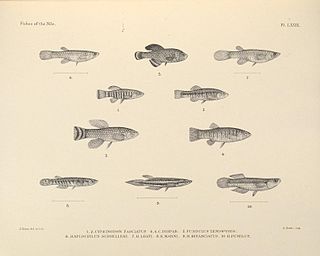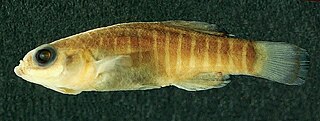George Sprague Myers was an American ichthyologist who spent most of his career at Stanford University. He served as the editor of Stanford Ichthyological Bulletin as well as president of the American Society of Ichthyologists and Herpetologists. Myers was also head of the Division of Fishes at the United States National Museum, and held a position as an ichthyologist for the United States Fish and Wildlife Service. He was also an advisor in fisheries and ichthyology to the Brazilian Government.

Aphanius, commonly referred to as Mediterranean killifish, is a genus of the order Cyprinodontiformes in the family Aphaniidae. They are found in fresh and brackish waters in the coastal plains of the Mediterranean region.
Campellolebias is a genus of killifish in the family Rivulidae from southeast Brazil. They are restricted to seasonal blackwater pools in forests in coastal parts of Santa Catarina and São Paulo states.
Esmaeilius vladykovi is a species of killifish in the family Aphaniidae endemic to a restricted area of the central Zagros Mountains of Iran. It can also be found in the aquarium trade. Its specific name honours the zoologist Vadim D. Vladykov (1898-1986) who studied the fishes of the Caspian basin and the person who accepted the species author, Brian W. Coad, as a graduate student.

Alfaro is a genus of poeciliid fishes endemic to Central America. The generic name honours the Costa Rican archaeologist, geologist, ethnologist, zoologist and Director of the National Museum of Costa Rica, Anastasio Alfaro (1865-1951).
Carlhubbsia is a genus of poeciliids native to Guatemala and Mexico. The name of this genus honours the American ichthyologist Carl Leavitt Hubbs (1894–1979) who originally named the genus Allophallus, a name which was preoccupied by a genus of Diptera.

Anatolichthys danfordii, the Kızılırmak toothcarp or Sultan Sazlığı toothcarp, is a species of killifish belonging to the family Aphaniidae. It is endemic to the Kızılırmak River and the upper Seyhan River drainage systems and is now restricted to a few locations in the Sultan Sazlığı marshes. Though little data is available, the population of the fish seems to be declining. The International Union for Conservation of Nature has rated its conservation status as being "critically endangered" and fears it may become extinct in the wild if the drainage of the marshes continues.
John Roxborough Norman was an English ichthyologist.

The Arabian toothcarp, known also as the Arabian toothcarp or mother-of-Pearl fish is a species of killifish belonging to the family Aphaniidae. It can be found from the shores of the Red Sea south to Ethiopia, the Gulf of Aden, the Arabian Sea and along the Persian Gulf east to Pakistan and India. It is also found in the Suez Canal, the northern coast of the Sinai Peninsula, and in one location on the Palestinian coast. The former recognized subspecies: A. d. richardsoni, the Dead Sea toothcarp endemic to the Dead Sea has now been raised to a full species as Aphaniops richardsoni.
The Dead Sea toothcarp is a species of toothcarp in the family Aphaniidae that is endemic to the Dead Sea basin. It is threatened by water fluctuation, and the introduction of cichlids and Gambusia. The specific name of this fish honours the Scottish surgeon and naturalist John Richardson (naturalist) (1787-1865) who first reported killifish in the Dead Sea basin. The Dead Sea toothcarp has been on the Red List of the International Union for Conversation of Nature since 2006.
The Sakarya toothcarp is a species of freshwater fish in the family Aphaniidae. It is endemic to the upper Sakarya River basin in Turkey. It is threatened by water abstraction, damming and a reduction of rainfall due to climate change. The specific name honours the German zoologist Wolfgang Villwock (1930-2014) of the University of Hamburg.

Tlaloc is a genus of fish in the family Profundulidae endemic to Mexico, Guatemala and Honduras. The genus is not, however, recognised by Fishbase or in the 5th Edition of Fishes of the World. The genus is named for Tlaloc the water god of the Aztecs.
Aapticheilichthys is a monotypic genus of killifish from the family Poeciliidae, the sole member being Aapticheilichthys websteri. A. websteri was found by the American fish breeder Kent Webster after which the species was named. The type locality was Akaka Camp on the western coastal plain of Gabon. A. websteri was collected from a river that was less than 10m wide on the night of the Asian tsunami, though it is not clear what effect of the tsunami may have had on the local ecosystem.
The Farsi toothcarp is a species of pupfish belonging to the family Aphaniidae. It is endemic to the Maharloo Lake Basin in Iran, residing in springs, lagoons, and marshes containing fresh to brackish water.

Esmaeilius is a genus of toothcarps in the family Aphaniidae. They are native to Iran and one species extending to Iraq. Most species in the genus have very small distributions and all are seriously threatened.

Paraphanius is a genus of killifishes in the family Aphaniidae, which are native to western Asia. Several species in the genus have very limited distribution and may be threatened.

Anatolichthys is a genus of toothcarps in the family Aphaniidae, which are native to Asia Minor. Several species in the genus have very limited distribution and may be threatened.

Aphaniops is a genus of killifishes in the family Aphaniidae, which are native to Western Asia, Northeast Africa and east to southwest India. Several species in the genus have very limited distribution and may be threatened.

Aphaniidae, the Oriental killifishes, are a family of the order Cyprinodontiformes. The 42 extant species of the family inhabit inland waters, rivers and lagoons. The distribution of these species extends from the entire Mediterranean region throughout the neighboring states of the Red Sea and Persian Gulf to southwest India. Several species in this family have very small distributions and are seriously threatened.
Cnesterodon pirai, the Almeida toothcarp, is a species of poeciliid that is only know from its type locality, the arroyo Almeida, an affluent of the arroyo Cuñá-Pirú, in the Río Paraná basin, Aristóbulo del Valle, Misiones in Argentina.








